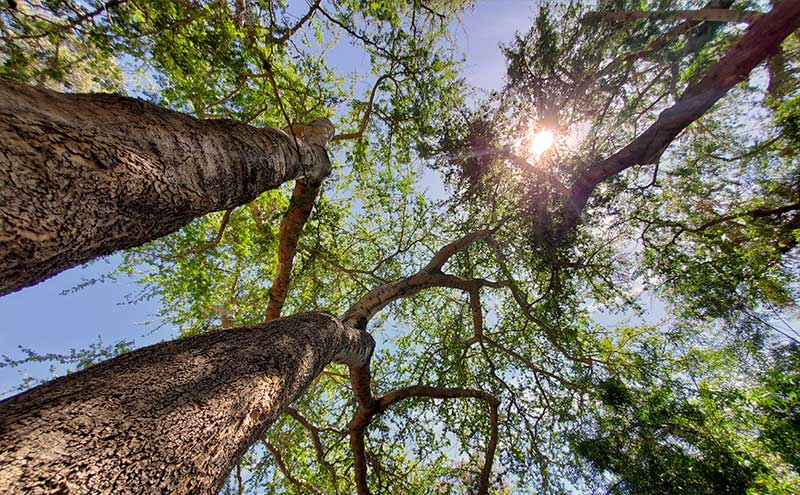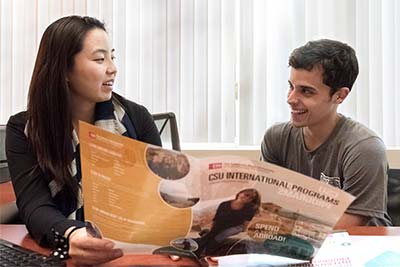Trees of the Arboretum
tree (trē) noun : tall, woody, perennial plants with trunks that support branches and leaves that gather light for photosynthesis.

Trees are an important component of any arboretum, a name that comes from the Latin word for “a place of trees.” Converted from an abandoned citrus orchard in the 1970s, Arboretum and Botanical Garden at Cal State Fullerton is now a living museum that cares for more than 1,500 trees from all over the world in its four major ecosystem collections.
Our stewardship of this green resource recognizes the critical importance of healthy trees, especially important now during the long-term western American drought and global climate disruption.
Benefits of Trees
The benefits that trees provide are extraordinary, improving communities and allowing natural environments to flourish. Here are a few ways they help:
Trees are nature’s master biochemical engineers. They absorb carbon dioxide (CO2), storing the carbon and releasing it back into the atmosphere as oxygen. This helps to mitigate greenhouse effects and slow climate disruption. They also take in pollutant gasses and odors, trapping them on their leaves, branches, and trunks.
Trees reduce rainfall runoff and thus prevent soil erosion. Their shade also helps cool the ground, shielding nearby plants and providing healthy soil and habitats for wildlife and insects. In an urban environment, trees provide a critical degree of cooling for streets, homes, and offices which in turn saves energy costs.
Trees are aesthetically beautiful and inspiring to look at and be around. Their presence provides a restful, restorative atmosphere in a stressful world. They muffle harsh sounds, slow down wind and dust, and increase property values. And what would a street or park be without the recreational values of trees?
Trees provide economic opportunity. For example, at Fullerton Arboretum, we seasonally harvest fruit from our working orchard and make it available for sale to the public. Forest trees on private and public lands are also harvested for their wood products, a renewable natural resource.
- Trees are nature’s master biochemical engineers. They absorb carbon dioxide (CO2), storing the carbon and releasing it back into the atmosphere as oxygen. This helps to mitigate greenhouse effects and slow climate disruption. They also take in pollutant gasses and odors, trapping them on their leaves, branches, and trunks.
- Trees reduce rainfall runoff and thus prevent soil erosion. Their shade also helps cool the ground, shielding nearby plants and providing healthy soil and habitats for wildlife and insects. In an urban environment, trees provide a critical degree of cooling for streets, homes, and offices which in turn saves energy costs.
- Trees are aesthetically beautiful and inspiring to look at and be around. Their presence provides a restful, restorative atmosphere in a stressful world. They muffle harsh sounds, slow down wind and dust, and increase property values. And what would a street or park be without the recreational values of trees?
- Trees provide economic opportunity. For example, at Fullerton Arboretum, we seasonally harvest fruit from our working orchard and make it available for sale to the public. Forest trees on private and public lands are also harvested for their wood products, a renewable natural resource.
From our massive Ombu, to the tall redwoods, to the stately Shamel ash and California oaks, we love our trees and invite you to come admire them in our 26-acre greenspace. We’re glad to share our botanical knowledge and recommendations with you.
Here are some additional resources for tree information:








